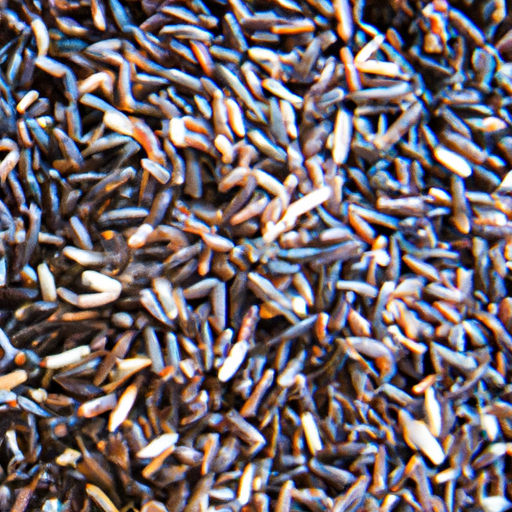Cooking with Black Rice: An Exquisite Grain Worth Exploring
Black rice, also known as forbidden rice, is a captivating and versatile ingredient. Throughout history, it has been revered for its distinctive appearance, delightful flavor, and numerous health benefits. Join us on a culinary adventure as we dive into the enchanting world of cooked black rice.
The Allure of Black Rice
With its deep, ebony hue and a lustrous, glossy sheen, black rice is a striking ingredient that adds a touch of elegance to any dish. Its intriguing color is due to the presence of anthocyanin, a powerful antioxidant found in the rice bran. Beyond its visual appeal, black rice boasts a nutty and slightly sweet flavor that tantalizes the taste buds.
A Star in Various Cuisines
Black rice, originating in ancient China, was once considered a delicacy reserved exclusively for emperors. Today, it has gained popularity worldwide and is cherished in diverse culinary traditions. Its rich, earthy taste pairs seamlessly with an array of ingredients, making it a capable companion for both sweet and savory dishes.
Common Uses in Cooking
In Asian cuisines, black rice is often used in hearty rice porridges and stir-fries. Its robustness stands up to robust flavors and can be employed in grain salads, pilafs, and even sushi. On the sweeter side, black rice is an exceptional choice for desserts such as rice pudding or custards. Its beautiful appearance and slightly sticky texture lend themselves well to visually stunning and deliciously satisfying dishes.
A Nutritional Powerhouse
Apart from its culinary allure, black rice offers significant nutritional benefits. Its deep pigmentation is an indicator of the presence of anthocyanins, potent antioxidants known for their role in fighting inflammation and reducing the risk of chronic diseases. Black rice is also an excellent source of dietary fiber, providing a gentle boost to digestive health. Furthermore, this remarkable grain contains essential minerals, including iron and magnesium, and packs a protein punch when compared to white or brown rice.
A Fascinating History
Black rice has a long and captivating history that stretches back thousands of years. In Ancient China, it earned the name “forbidden rice” because it was exclusively reserved for the royal court, and commoners were prohibited from consuming it. Legend has it that eating black rice would grant longevity and good health.
Fast forward to today, and black rice is widely accessible, appreciated, and enjoyed by people around the globe. Its cultural significance remains, as it symbolizes prosperity, wealth, and happiness in many Asian cultures.
Cooking Perfectly Tender Black Rice
Cooking black rice is straightforward, but it does require a bit of patience and attention. Here’s how to prepare exceptionally tender and delightful black rice:
- Measure out the desired amount of black rice and rinse it under cold water to remove any impurities.
- In a saucepan, combine the rice with the appropriate amount of water. A general rule of thumb is to use a 1:2 ratio of rice to water.
- Bring the mixture to a boil over medium-high heat, then reduce the heat to low and cover the pan.
- Simmer the rice for approximately 30-40 minutes, or until the grains are tender and have absorbed all the liquid.
- Remove the pan from the heat and let the rice rest, covered, for an additional 5-10 minutes.
- Fluff the rice with a fork before serving, ensuring that each grain remains separate and tender.
Elevate Your Culinary Repertoire with Black Rice
With its captivating appearance, delightful flavor, and impressive health benefits, black rice is a true gem in the world of grains. Incorporate it into your cooking repertoire to create visually stunning and nourishing dishes that will transport you to distant lands. From stir-fries to desserts, black rice is a versatile ingredient that will add a touch of intrigue and sophistication to your culinary adventures. So go ahead, dive into the enchanting world of black rice and let your taste buds rejoice in its unique splendor.
Note: Before cooking, always refer to the specific cooking instructions on the package of black rice for the best results.
Black Rice
Origin: Black rice, also known as forbidden rice or purple rice, is an ancient grain that is believed to have originated in China. It was first cultivated in Asia and has been grown for centuries.
Common Uses: Cooked black rice is commonly used in both sweet and savory dishes. In Asian cuisine, it is often used in desserts, puddings, porridge, and as a filling for dumplings. It can also be used as a side dish, in salads, or as a base for stir-fries.
Nutritional Benefits: Black rice is highly nutritious and is often considered a healthier alternative to white rice. It is a good source of fiber, vitamins, and minerals. It also contains antioxidants called anthocyanins, which give the rice its unique black color. These antioxidants have been associated with various health benefits, including reducing inflammation and promoting heart health.
Unique Properties: Black rice has a nutty flavor and a slightly chewy texture. When cooked, it turns a deep purple or black color due to its high anthocyanin content. This color can add visual interest and appeal to dishes. The husks of black rice are also rich in phytochemicals, which are believed to have potential health benefits.
Historical Significance: Black rice has a long history and was once considered a luxury food reserved only for emperors in ancient China. In fact, it got its name “forbidden rice” because it was believed that consuming it could prolong the emperor’s life and provide him with good health. Today, black rice is more widely available and enjoyed by people around the world.




Use the share button below if you liked it.
It makes me smile, when I see it.